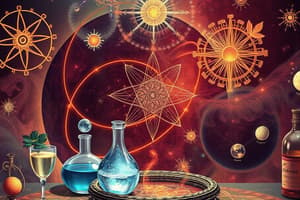Podcast
Questions and Answers
What distinction is made between organic and inorganic compounds?
What distinction is made between organic and inorganic compounds?
- Organic compounds must contain at least one nitrogen atom.
- Inorganic compounds consist solely of minerals.
- Organic compounds require at least two carbon atoms and can include other elements. (correct)
- Inorganic compounds are only metals.
Which statement accurately represents the Second Law of Thermodynamics?
Which statement accurately represents the Second Law of Thermodynamics?
- Energy changes always result in a more useful form of energy.
- Energy is transformed without any loss of effectiveness.
- Energy can be created as it shifts forms.
- Energy changes results in a less useful form of energy over time. (correct)
What is a positive feedback loop?
What is a positive feedback loop?
- A change that results in a reinforcing effect, pushing a system further in the same direction. (correct)
- A process that stabilizes a system by dampening changes.
- A delay in response due to the accumulation of input stimuli.
- A feedback mechanism that results in immediate contradiction of input.
What does the Law of Conservation of Matter state?
What does the Law of Conservation of Matter state?
What is a tipping point in the context of systems?
What is a tipping point in the context of systems?
Which of the following components is NOT part of Earth's life support system?
Which of the following components is NOT part of Earth's life support system?
What are the three factors necessary to sustain life on Earth?
What are the three factors necessary to sustain life on Earth?
Which of the following best describes a food web?
Which of the following best describes a food web?
In the context of ecosystems, what role do decomposers play?
In the context of ecosystems, what role do decomposers play?
What is the significance of the Pyramid of Energy Flow?
What is the significance of the Pyramid of Energy Flow?
What is the primary difference between Gross Primary Productivity (GPP) and Net Primary Productivity (NPP)?
What is the primary difference between Gross Primary Productivity (GPP) and Net Primary Productivity (NPP)?
Which of the following correctly defines biological evolution?
Which of the following correctly defines biological evolution?
What aspect of biodiversity is represented by the number of different species present in an ecosystem?
What aspect of biodiversity is represented by the number of different species present in an ecosystem?
What process describes when an existing species divides into two or more distinct species?
What process describes when an existing species divides into two or more distinct species?
What is a characteristic of endemic species?
What is a characteristic of endemic species?
Which type of extinction occurs when a species ceases to exist globally?
Which type of extinction occurs when a species ceases to exist globally?
Which of the following describes ecological niche?
Which of the following describes ecological niche?
Which term refers to the comparative number of individuals of each species present in an ecosystem?
Which term refers to the comparative number of individuals of each species present in an ecosystem?
What defines a generalist species?
What defines a generalist species?
Which type of species serves as an early warning system for ecosystem damage?
Which type of species serves as an early warning system for ecosystem damage?
What is indicated by the carrying capacity of an environment?
What is indicated by the carrying capacity of an environment?
Which factor is NOT considered a limiting factor in population growth?
Which factor is NOT considered a limiting factor in population growth?
What characterizes secondary ecological succession?
What characterizes secondary ecological succession?
What happens during exponential growth?
What happens during exponential growth?
A keystone species is best defined as:
A keystone species is best defined as:
Which of the following statements about ecological succession is true?
Which of the following statements about ecological succession is true?
What is inertia in the context of living systems?
What is inertia in the context of living systems?
What does resilience in living systems refer to?
What does resilience in living systems refer to?
Which factor contributes to the size of the human population?
Which factor contributes to the size of the human population?
What is one suggested method to slow human population growth?
What is one suggested method to slow human population growth?
What was the world population growth rate reported in 2018?
What was the world population growth rate reported in 2018?
Study Notes
Atomic Theory
- All elements are made up of atoms
- Atoms combine to form molecules, held together by chemical bonds
- Ions are atoms or groups of atoms with a net positive or negative charge
- Organic Compounds - at least two carbon atoms plus atoms of one or more elements
- Inorganic Compounds - all other compounds with one exception, methane (CH4)
Organic Compounds:
- Examples of simple organic compounds include hydrocarbons, chlorinated hydrocarbons, and simple carbohydrates.
- Complex organic compounds include complex carbohydrates, proteins, and nucleic acids
Matter and Energy
- Matter undergoes physical, chemical, and nuclear changes.
- Law of Conservation of Matter: Matter cannot be created or destroyed - only transformed.
- Energy comes in various forms, including kinetic and potential energy.
- Law of Conservation of Energy: Energy cannot be created or destroyed, only transformed.
- Second Law of Thermodynamics: When energy changes form, it moves from a more useful to a less useful form.
Systems and Feedback Loops
- Systems have inputs, flows, and outputs.
- Feedback loops occur when an output is fed back into the system as an input, leading to changes.
- Positive Feedback Loop : Causes a system to change further in the same direction.
- Negative Feedback Loop: Causes a system to change in the opposite direction.
- Time Delay: A period between an input stimulus and a system's response.
- Tipping Point: A point where a system's behavior fundamentally shifts.
Earth's Life Support System
- Components: Atmosphere (Troposphere & Stratosphere), Geosphere, Hydrosphere, Biosphere
- Three Factors for Sustaining Life:
- One-way flow of high-quality energy
- Cycling of nutrients
- Gravity
Ecology
- Ecology studies how organisms interact with each other and their non-living environment.
- Organisms: Individual living beings
- Population: Group of individuals of the same species living in a particular area
- Communities: Interactions between populations of different species within a given area
- Ecosystems: Interactions between a community and their non-living environment
- Biosphere: Parts of the Earth's air, water, and soil that support life
Roles of Organisms
- Producers: Use photosynthesis to create nutrients from environmental components
- Consumers: Obtain nutrients by feeding on other organisms
- Decomposers: Break down organic detritus into simpler inorganic compounds
- Detritivores: Feed on waste or dead bodies
Types of Respiration:
- Aerobic Respiration
- Anaerobic Respiration
Food Chains and Webs
- Food Chain: A linear sequence of organisms, each serving as a source of food for the next.
- Food Web: A complex network of interconnected food chains.
- Biomass: The dry weight of all living organisms in an ecosystem.
- Pyramid of Energy Flow : Shows the decrease of usable energy at each trophic level (approximately 90% loss with each transfer).
Productivity
- Gross Primary Productivity (GPP): Rate at which producers convert solar energy to chemical energy.
- Net Primary Productivity (NPP): GPP minus the energy producers use through respiration.
Water and Nutrient Cycles
- Water Cycle: The continuous movement of water on, above, and below the surface.
- Nutrient Cycles: Circular pathways of key elements (Carbon, Nitrogen, Phosphorus, Sulfur) through the environment.
Studying Ecosystems
- Field Research, Remote Sensing Devices, Geographic Information Systems, Laboratory Research, and Computer Simulations
Biodiversity
- Biological Diversity: Variety of Earth's species, their genes, ecosystems, and ecological processes.
- Major Components:
- Species Diversity
- Ecological Diversity
- Genetic Diversity
- Functional Diversity
Evolution
- Biological Evolution: Changes in the genetic makeup of populations over time.
- Natural Selection: Individuals with advantageous traits are more likely to survive and reproduce.
- Speciation: One species splits into two or more distinct species (Geographic isolation followed by Reproductive isolation).
- Extinction: The complete disappearance of a species.
- Local Extinction: A species disappears from a region but not globally.
- Endemic Species - species found exclusively in one area, prone to extinction.
- Background Extinction: Gradual extinction rates over time.
- Mass Extinction: Widespread and rapid extinction of a large number of species.
Species Diversity
- Species Richness: Number of different species present.
- Species Evenness: Relative abundance of individuals for each species.
Ecological Niche
- Species' way of life within an ecosystem, including factors like food, shelter, and reproduction.
Generalist & Specialist Species
- Generalist: Wide range of tolerances, adapts to various environments and foods.
- Specialist: Narrow range of tolerances, thrives in specific habitats and food sources.
Roles of Species
- Native: Naturally occur and thrive in an ecosystem.
- Non-native (Introduced): Species introduced to an ecosystem, can threaten native species.
- Indicator: Early warning signs of damage to a community or ecosystem.
- Keystone: Significant impact on the types and abundance of other species in an ecosystem.
- Foundation: Shape their communities by creating habitats beneficial to other species.
Species Interactions
- Interspecific Competition: Competition between different species for resources (food, space, etc.).
- Predation: One species (predator) hunting and consuming another (prey).
- Parasitism: One organism (parasite) lives in or on another (host), benefiting at the host's expense.
- Mutualism: Both species mutually benefit from the interaction.
- Commensalism: One species benefits, while the other is neither harmed nor benefited.
Population Control
- Limiting Factor Principle: Too much or too little of any factor can limit population growth.
- Environmental Resistance: Factors that limit population growth (e.g., disease, competition, predation).
- Carrying Capacity: Maximum population size a habitat can sustain indefinitely.
Population Growth
- Exponential Growth: Unrestricted growth in favorable conditions, resulting in a J-shaped curve.
- Dieback (Population Crash): Occurs when a population exceeds carrying capacity and resources become depleted.
Ecological Succession
- Gradual change in species composition over time:
- Primary Succession : Establishment of biotic communities in lifeless areas without soil or sediment.
- Secondary Succession: Re-establishment of a community in areas with existing soil or sediment after a disturbance.
Stability of Living Systems
- Inertia (Persistence): Ability of a system to withstand moderate disturbances.
- Resilience: Ability of a system to recover from a severe disturbance through secondary succession.
Studying That Suits You
Use AI to generate personalized quizzes and flashcards to suit your learning preferences.
Related Documents
Description
Explore key concepts in atomic theory, including the composition of matter and the distinctions between organic and inorganic compounds. Delve into the laws of conservation of matter and energy, and understand the transformations that occur in physical and chemical changes.




